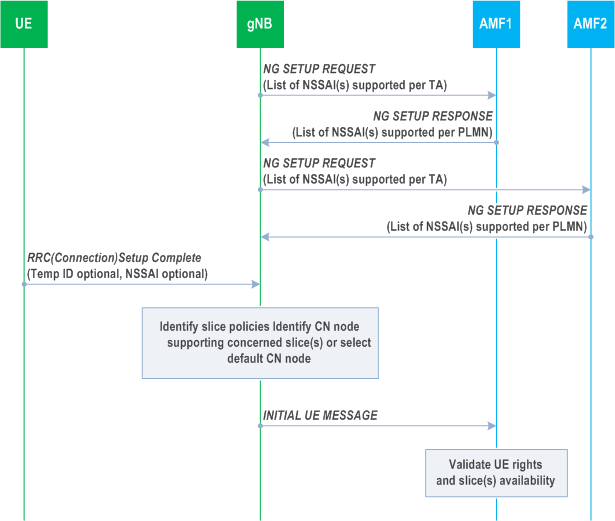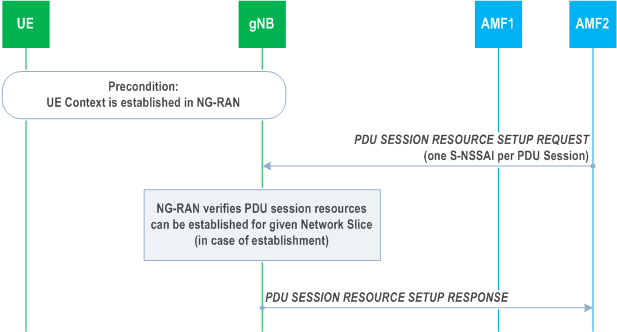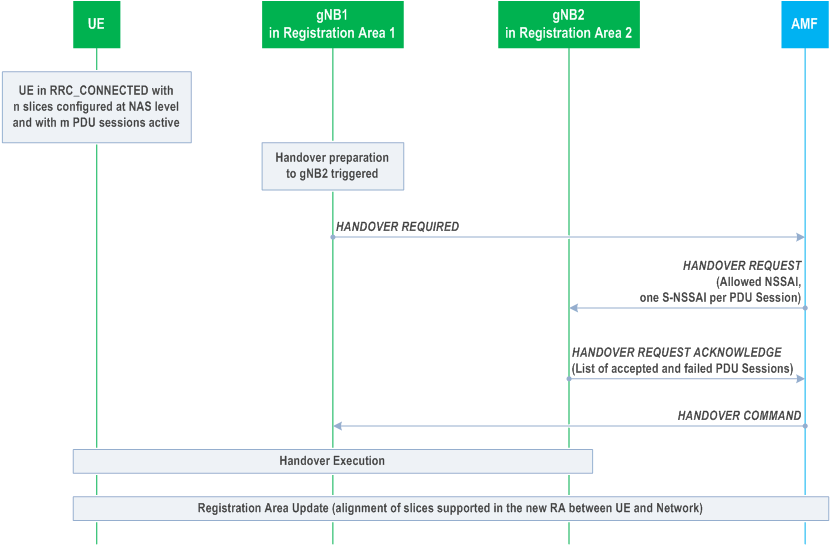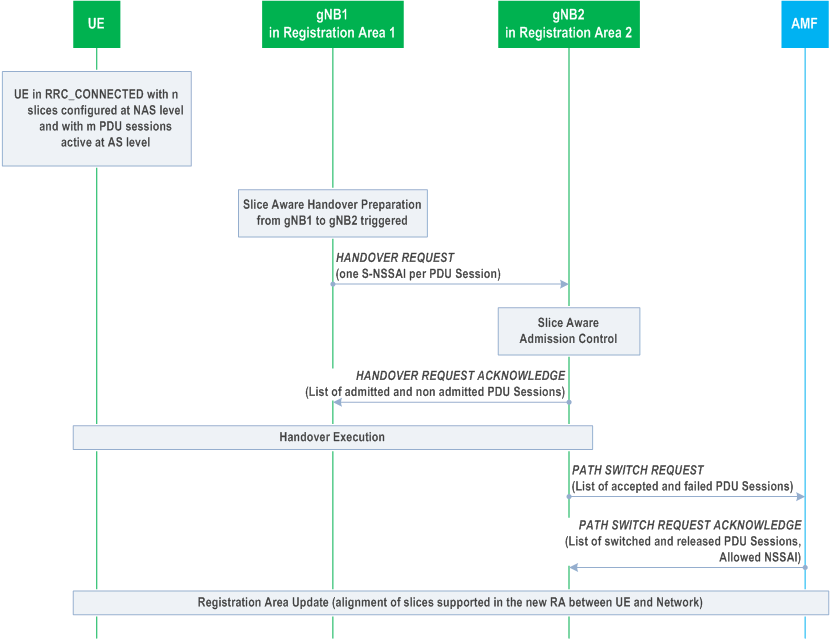Content for TS 38.300 Word version: 18.4.0
1…
4…
4.7…
5…
5.3…
5.4…
6…
6.2…
6.6…
7…
8…
9…
9.2.2…
9.2.2.5…
9.2.3…
9.2.3.2…
9.2.3.3…
9.2.4…
9.2.6…
9.3…
10…
11…
15…
15.5…
16…
16.2…
16.3…
16.4…
16.8…
16.9…
16.10…
16.12…
16.12.5…
16.12.6…
16.12.6.3
16.12.7
16.13…
16.14…
16.15…
16.18…
16.19…
16.21…
16.21.3…
17…
18…
19
20…
21…
A…
B…
C…
G…
16.3 Network Slicing
16.3.1 General Principles and Requirements
16.3.2 AMF and NW Slice Selection
16.3.2.1 CN-RAN interaction and internal RAN aspects
16.3.2.2 Radio Interface Aspects
16.3.3 Resource Isolation and Management
16.3.3.1 General
16.3.3.2 Handling of Slice Resources
16.3.3a Slice-based cell reselection
16.3.4 Signalling Aspects
16.3.4.1 General
16.3.4.2 AMF and NW Slice Selection
16.3.4.3 UE Context Handling
16.3.4.4 PDU Session Setup Handling
16.3.4.5 Mobility
...
...
16.3 Network Slicing p. 152
16.3.1 General Principles and Requirements p. 152
In this clause, the general principles and requirements related to the realization of network slicing in the NG-RAN for NR connected to 5GC and for E-UTRA connected to 5GC are given.
A network slice always consists of a RAN part and a CN part. The support of network slicing relies on the principle that traffic for different slices is handled by different PDU sessions. Network can realise the different network slices by scheduling and also by providing different L1/L2 configurations.
Each network slice is uniquely identified by a S-NSSAI, as defined in TS 23.501. NSSAI (Network Slice Selection Assistance Information) includes one or a list of S-NSSAIs (Single NSSAI) where a S-NSSAI is a combination of:
- mandatory SST (Slice/Service Type) field, which identifies the slice type and consists of 8 bits (with range is 0-255);
- optional SD (Slice Differentiator) field, which differentiates among Slices with same SST field and consist of 24 bits.
- NG-RAN supports a differentiated handling of traffic for different network slices which have been pre-configured. How NG-RAN supports the slice enabling in terms of NG-RAN functions (i.e. the set of network functions that comprise each slice) is implementation dependent.
- NG-RAN supports the selection of the RAN part of the network slice, by NSSAI provided by the UE or the 5GC which unambiguously identifies one or more of the pre-configured network slices in the PLMN.
- NG-RAN supports policy enforcement between slices as per service level agreements. It should be possible for a single NG-RAN node to support multiple slices. The NG-RAN should be free to apply the best RRM policy for the SLA in place to each supported slice.
- NG-RAN supports QoS differentiation within a slice, and per Slice-Maximum Bit Rate may be enforced per UE, if feasible. How NG-RAN enables UE-Slice-MBR enforcement and rate limitation (see TS 23.501) is up to network implementation.
- For initial attach, the UE may provide NSSAI to support the selection of an AMF. If available, NG-RAN uses this information for routing the initial NAS to an AMF. If the NG-RAN is unable to select an AMF using this information or the UE does not provide any such information the NG-RAN sends the NAS signalling to one of the default AMFs.
- For subsequent accesses, the UE provides a Temp ID, which is assigned to the UE by the 5GC, to enable the NG-RAN to route the NAS message to the appropriate AMF as long as the Temp ID is valid (NG-RAN is aware of and can reach the AMF which is associated with the Temp ID). Otherwise, the methods for initial attach applies.
- The NG-RAN supports resource isolation between slices. NG-RAN resource isolation may be achieved by means of RRM policies and protection mechanisms that should avoid that shortage of shared resources in one slice breaks the service level agreement for another slice. It should be possible to fully dedicate NG-RAN resources to a certain slice. Some RACH resources can be associated to specific NSAG(s). Other aspects how NG-RAN supports resource isolation is implementation dependent.
- By means of the unified access control (see clause 7.4), operator-defined access categories can be used to enable differentiated handling for different slices. NG-RAN may broadcast barring control information (i.e. a list of barring parameters associated with operator-defined access categories) to minimize the impact of congested slices.
- Some slices may be available only in part of the network. A slice is considered available in a cell if it is supported by the TA comprising the cell and the slice is not configured with zero resources, as specified in TS 23.501. A slice is supported within a TA if the NG-RAN has been configured to support the S-NSSAI in the TA. All supported slices are included in the slice support list for the TA signalled from the NG-RAN to the AMF. The NG-RAN supported S-NSSAI(s), NSAG(s) and NSAG related information such as NSAG associated Cell Reselection Priority and/or NSAG associated RACH resources are configured by OAM. Awareness in the NG-RAN of the slices supported in the cells of its neighbours may be beneficial for inter-frequency mobility in connected mode. In order to support the NSAG, the NG-RAN provides the AMF with the NSAG information per TA in the appropriate NG interface management procedures, as specified in TS 38.413. Awareness in the NG-RAN of the NSAG information supported in the list(s) of neighbour cells may be configured by OAM, or exchanged with neighbour NG-RAN nodes.
- The NG-RAN and the 5GC are responsible to handle a service request for a slice that may or may not be available in a given area. Admission or rejection of access to a slice may depend by factors such as support for the slice, availability of resources, support of the requested service by NG-RAN.
- The NG-RAN may be signalled with the Partially Allowed NSSAI from the AMF as specified in TS 23.501. The NG-RAN may decide to use the Partially Allowed NSSAI for mobility decision.
- Support for Network Slices with Network Slice Area of Service not matching deployed Tracking Areas is specified in TS 23.501. NG-RAN cells that are outside the Area of Service may be configured with zero resources for the concerned slice(s). The concerned slice(s) cannot use any dedicated, prioritized nor any shared resources of that cell. Awareness of zero resources configured for a slice in one or more cells may be exchanged with neighbour NG-RAN nodes for mobility reasons.
- In case a UE is associated with multiple slices simultaneously, only one signalling connection is maintained and for intra-frequency cell reselection, the UE always tries to camp on the best cell. For inter-frequency cell reselection, dedicated priorities can be used to control the frequency on which the UE camps.
- Slice awareness in NG-RAN is introduced at PDU session level, by indicating the S-NSSAI corresponding to the PDU Session, in all signalling containing PDU session resource information.
- It is the responsibility of the 5GC to validate that the UE has the rights to access a network slice. Prior to receiving the Initial Context Setup Request message, the NG-RAN may be allowed to apply some provisional/local policies, based on awareness of which slice the UE is requesting access to. During the initial context setup, the NG-RAN is informed of the slice for which resources are being requested.
- NG-RAN may support network slice replacement for a PDU session as defined in TS 23.501.
16.3.2 AMF and NW Slice Selection p. 154
16.3.2.1 CN-RAN interaction and internal RAN aspects p. 154
NG-RAN selects AMF based on a Temp ID or NSSAI provided by the UE over RRC as specified in TS 38.410. The mechanisms used in the RRC protocol are described in the next clause.
| Temp ID | NSSAI | AMF Selection by NG-RAN |
|---|---|---|
| not available or invalid | not available | One of the default AMFs is selected (NOTE) |
| not available or invalid | present | Selects AMF which supports UE requested slices |
| valid | not available, or present | Selects AMF per CN identity information in Temp ID |
|
NOTE:
The set of default AMFs is configured in the NG-RAN nodes via OAM.
|
||
16.3.2.2 Radio Interface Aspects p. 154
When triggered by the upper layer, the UE conveys the NSSAI over RRC in the format explicitly indicated by the upper layer.
16.3.3 Resource Isolation and Management p. 155
16.3.3.1 General |R17| p. 155
Resource isolation enables specialized customization and avoids one slice affecting another slice.
Hardware/software resource isolation is up to implementation. Each slice may be assigned with either shared, prioritized or dedicated radio resource up to RRM implementation and SLA as in TS 28.541.
To enable differentiated handling of traffic for network slices with different SLA:
- NG-RAN is configured with a set of different configurations for different network slices by OAM;
- To select the appropriate configuration for the traffic for each network slice, NG-RAN receives relevant information indicating which of the configurations applies for this specific network slice.
16.3.3.2 Handling of Slice Resources |R17| p. 155
The NG-RAN node may use Multi-Carrier Resource Sharing or Resource Repartitioning to allocate resources to a slice during the procedures described in clause 16.3.4 to support the slice service continuity in case of slice resources shortage.
In Multi-Carrier Resource Sharing the RAN node can setup the dual connectivity or carrier aggregation with different frequency and overlapping coverage where the same slice is available.
The Resource Repartitioning allows a slice to use resources from the shared pool or/and prioritized pool when its own dedicated or prioritized resources are not available and the use of unused resources in the prioritized pool is as specified in TS 28.541.
Slice RRM policies/restrictions associated with Resource Repartitioning are configured from O&M.
Measurements of RRM policy utilization according to resource types defined in TS 28.541 are reported from RAN nodes to O&M and may lead O&M to update the configuration of the Slice RRM policies/restrictions.
16.3.3a Slice-based cell reselection |R17| p. 155
Slice-based cell reselection information can be included in SIB16 and in RRCRelease messages. The slice-based cell reselection information may include reselection priorities per NSAG per frequency and corresponding list(s) of cells where the slices of the NSAG are supported or not supported. The UE determines the NSAG(s) and their priorities to be considered during cell reselection as specified in TS 23.501, and in TS 38.304.
When a UE supports slice-based cell reselection, and when slice-based cell reselection information is provided to the UE, then the UE uses the slice-based cell reselection information. Valid cell reselection information provided in RRCRelease always has a priority over cell reselection information provided in SIB messages. When no slice-based cell reselection information is provided for any NSAG that was determined to be considered during cell reselection (as specified in TS 23.501), then the UE uses the general cell reselection information, i.e., without considering the NSAG(s) and their priorities.
16.3.4 Signalling Aspects p. 155
16.3.4.1 General p. 155
In this clause, signalling flows related to the realization of network slicing in the NG-RAN are given.
16.3.4.2 AMF and NW Slice Selection p. 156
RAN selects the AMF based on a Temp ID or NSSAI provided by the UE.

In case a Temp ID is not available, the NG-RAN uses the NSSAI provided by the UE at RRC connection establishment to select the appropriate AMF (the information is provided after MSG3 of the random access procedure). If such information is also not available, the NG-RAN routes the UE to one of the configured default AMF(s).
The NG-RAN uses the list of supported S-NSSAI(s) previously received in the NG Setup Response message when selecting the AMF with the NSSAI. This list may be updated via the AMF Configuration Update message.
16.3.4.3 UE Context Handling p. 156
Following the initial access, the establishment of the RRC connection and the selection of the correct AMF, the AMF establishes the complete UE context by sending the Initial Context Setup Request message to the NG-RAN over NG-C. The message contains the Allowed NSSAI and additionally contains the S-NSSAI(s) as part of the PDU session(s) resource description when present in the message and may contain Partially Allowed NSSAI. Upon successful establishment of the UE context and allocation of PDU session resources to the relevant network slice(s) when present, the NG-RAN responds with the Initial Context Setup Response message.

16.3.4.4 PDU Session Setup Handling p. 157
When new PDU sessions need to be established, the 5GC requests the NG-RAN to allocate/ resources relative to the relevant PDU sessions by means of the PDU Session Resource Setup procedures over NG-C. One S-NSSAI is added per PDU session to be established, so NG-RAN is enabled to apply policies at PDU session level according to the SLA represented by the network slice, while still being able to apply (for example) differentiated QoS within the slice.
NG-RAN confirms the establishment of the resources for a PDU session associated to a certain network slice by responding with the PDU Session Resource Setup Response message over the NG-C interface.

16.3.4.5 Mobility p. 157
To make mobility slice-aware in case of Network Slicing, S-NSSAI is introduced as part of the PDU session information that is transferred during mobility signalling. This enables slice-aware admission and congestion control.
Both NG and Xn handovers are allowed regardless of the slice support of the target NG-RAN node i.e. even if the target NG-RAN node does not support the same slices as the source NG-RAN node. An example for the case of connected mode mobility across different Registration Areas is shown in Figure 16.3.4.5-1 for the case of NG based handover and in Figure 16.3.4.5-2 for the case of Xn based handover.

